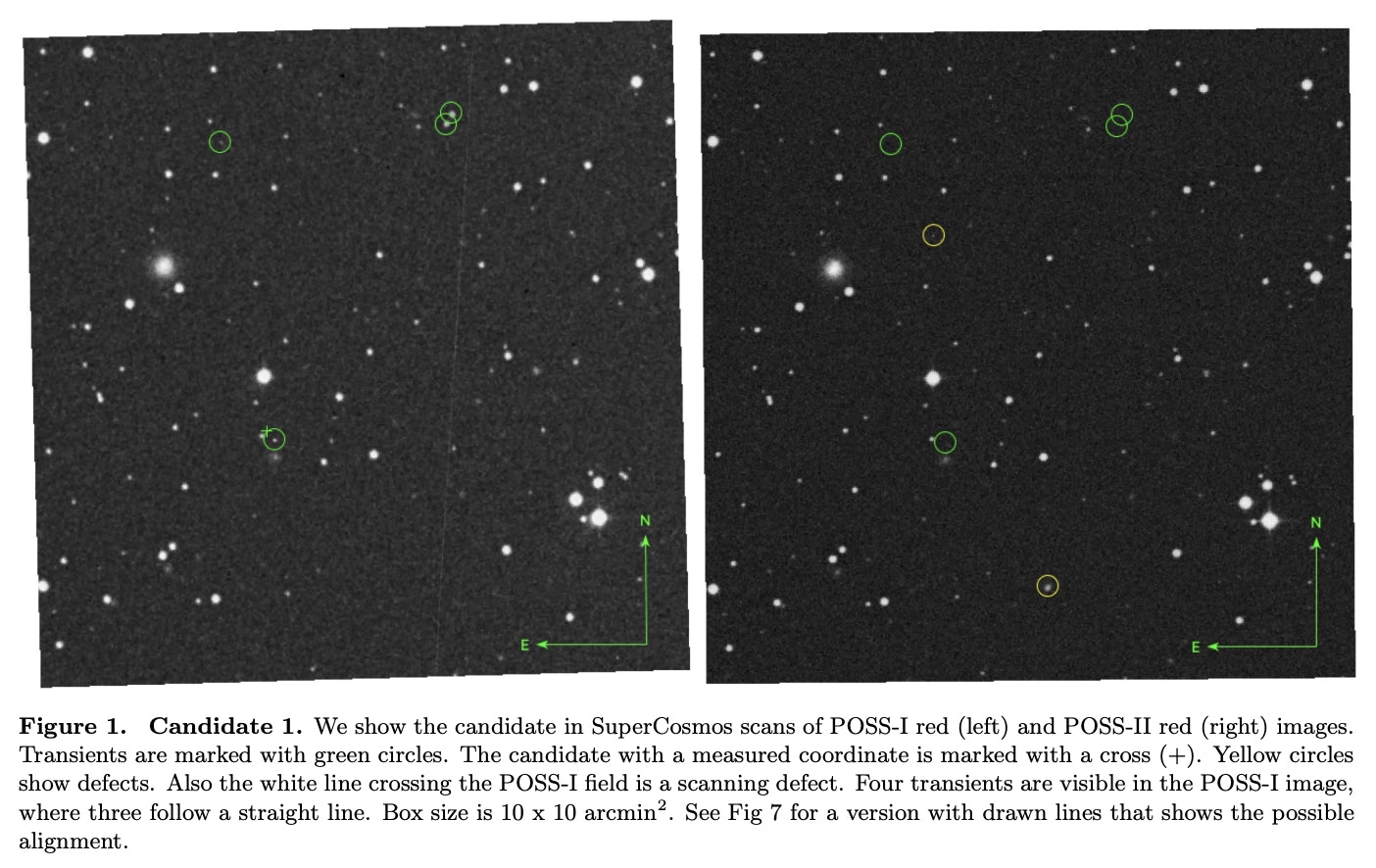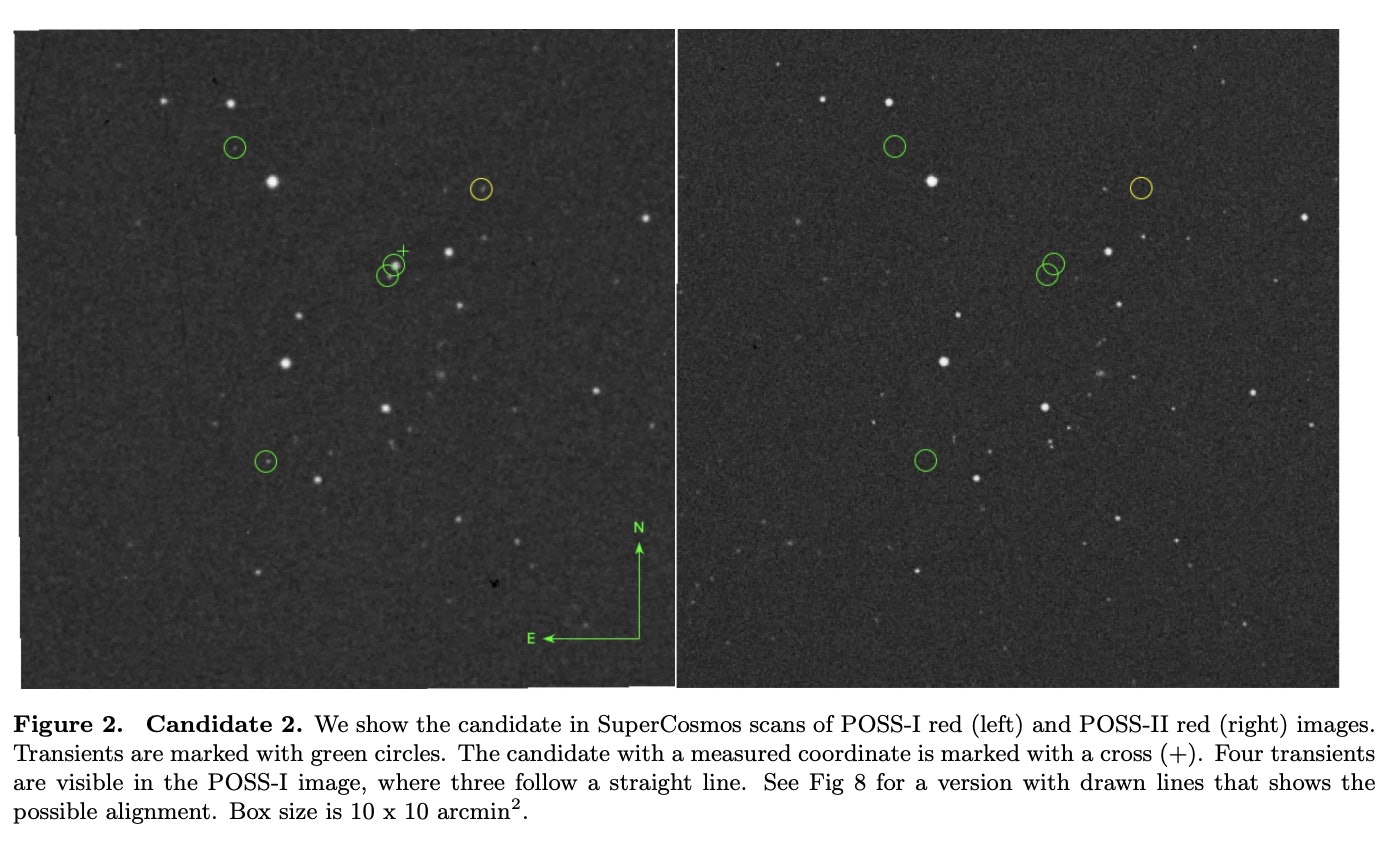
On a series of 70-year-old photographic plates containing images of the night sky, a few astronomers say they’ve found something weird: flashes of light that appear and then disappear, like ghosts.
“We found one image where nine stars were out there, and they vanished. And they are not there half an hour earlier, and they are not there six days later,” says Beatriz Villarroel, a postdoctoral researcher at the Nordic Institute for Theoretical Physics. “And you wonder, ‘Is this real?’”
There isn’t any readily available astronomical explanation for what these vanishing points of light, which the researchers call transients, might be. The dots might be defects in the photographic emulsions or image artifacts from when astronomers first scanned the plates. But in a series of recent papers, Villarroel and a small team of astronomers have been more seriously probing the possibility that the flashes might be something more exciting — extraterrestrial objects.
A shiny, spinning object passing by Earth would leave a line of dots in a long-exposure image of the night sky. Asteroids or meteors aren’t likely to look like that — most asteroids are dark, and meteors are moving so fast they’d look like streaks. And, most intriguingly for the researchers, there weren’t any satellites in the night sky when the images were taken, as all the plates were before the launch of Sputnik.
Still, Villarroel and colleagues haven’t ruled out Earthly explanations for these tantalizing dots. And there’s a long history of events associated with the search for extraterrestrial intelligence (SETI) fizzling out under closer scrutiny.
What they found — The disappearing dots that got Villarroel so excited first showed up as part of a search for more mundane astronomical phenomena. There are a number of things in the universe that will shine brightly for a short period and disappear again, like supernovae, actively feeding black holes, flaring stars, and more. But searching for these transient objects is nearly impossible today because of the thousands of satellites and millions of pieces of space debris in orbit around Earth, many of which appear as momentary flashes of light in photos of the night sky.
“The whole sky is filled with multiple transients today from all the space debris,” Villarroel says.
So she and other astronomers turned to photos of the night sky taken before the satellite era. Beginning in the late 19th century, astronomers have undertaken surveys of the night sky, using telescopes and photographic plates to take images of large swaths of the cosmos as seen from Earth. Villarroel used a series of plates from the Palomar Observatory Sky Survey, which ran from 1949 to 1958 and covered much of the sky as seen from the northern hemisphere, on the hunt for transients.

Her research is part of the Vanishing and Appearing Sources during a Century of Observations (VASCO) project, which, along with an associated citizen science project, is searching for transient light sources in the night sky. But after looking at the plates carefully, Villarroel and her colleagues noticed something odd: Nine dots of light, all in a line, appeared in just one plate from April 12, 1950. It didn’t look anything like the supernovas and quasars they’d normally find, which appear just as single points.
In a paper published in Scientific Reports in 2021, the scientists take a closer look at the nine transients to see if they could find a more ordinary explanation for them. They ruled out astrophysical explanations, passing airplanes, asteroids, and other known light sources. The dots could have come from contamination caused by nuclear fallout, they say — it was the era of nuclear experimentation, after all. But no known tests happened in 1950. Villarroel and her colleagues hint that that leaves the door open to other explanations. Like, say, extraterrestrial spacecraft.

Wanting to believe — In two subsequent papers, the researchers take that idea more seriously. In a paper in Acta Astronautica published in 2022, they explore ways to find similar instances of transients in other images, laying the groundwork for future research. And in a paper published in 2022 to the pre-print server the arXiv (meaning it hasn’t been peer-reviewed yet), the researchers detail other instances of transient flashes of light that seem to line up.
Villarroel isn’t saying it’s aliens, of course. “We are very careful when we write our papers, because we are not sure if they are real or not,” she says. “We need to always assume that it is the most boring explanation.”
There are some good reasons to suspect the explanation is indeed more boring, says Paul Horowitz, an emeritus professor of physics and electrical engineering at Harvard and a member of the ET-hunting PANOSETI project, who was not involved in the study.
He used the Palomar plates earlier in his career, he says, and the presence of odd flashes of light doesn’t surprise him.
“There would be these things that we’d call Kodak stars, which were basically blemishes in the emulsion,” Horowitz says. “Film is full of that kind of stuff. If you look at enough of these, and there’s a lot of them, you’re going to find artifacts.”
He also points out that the object, if there was one, needn’t be in geosynchronous orbit, as Villarroel and her coauthors suggest. Depending on how often it flashes and how long the flashes are, an object could appear as a series of dots in a long exposure at a range of distances, from within Earth’s atmosphere to far beyond our planet. That could mean whatever’s on the plates could also be something launched from Earth.

An earthly object might be the best explanation for the flashing lights, Eliot Gillum, the director of optical SETI at the SETI Institute, tells Inverse. While there weren’t any satellites in 1950, the U.S. government had begun testing rockets several years earlier, relying on expertise from ex-Nazi scientists brought to the U.S. after the Second World War. There are several military bases near the Palomar Observatory, Gillum points out, any of which could have been launching rockets by 1950. He says the glints could come from a maneuver known as a roll program or from debris that broke off after launch.
There’s also ample precedent for seemingly wild observations turning out to be far more prosaic. In 1962, two French astronomers were stunned to discover that the stars they were observing were giving off massive flares of potassium, something astronomers had never seen a star do before. But on closer inspection, the “potassium flare stars” were just match heads, which had potassium in them, being lit by astronomers taking a smoke break at the observatory. And more recently, scientists studying Fast Radio Bursts were excited by what appeared to be strange new signals coming from near Earth — only to discover later they were from a microwave warming up the astronomers’ lunches.
Even if the mysterious flashes of light aren’t extraterrestrials, that doesn’t mean we haven’t learned anything, Gillum says. “One of the things that I think is truly great about SETI is that it says, ‘OK, I think I understand all of the science of the things out there, [so] what is on the edge, what is outside of what I understand?’” he says.
Exploring the edges of science could bring new insights — or, sometimes, simple explanations like dust grains that landed on photographic plates seventy years ago. But Villarroel says that if their research rules out an actual object, it suggests an upper limit on the number of extraterrestrial objects that could be near Earth. At one-billionth for every square kilometer of space, the number is tiny — not a great sign for people hoping to find extraterrestrials visiting our solar system.
Villarroel says she hopes to be able to study the Palomar plates themselves — her team had been using scanned images of them — to study the images with a microscope for a better look at the transients. And she’d like to look at images from other sky surveys to see if similar transients appear. It may be that there was indeed something out there on April 12, 1950. But what it was is still a mystery.







